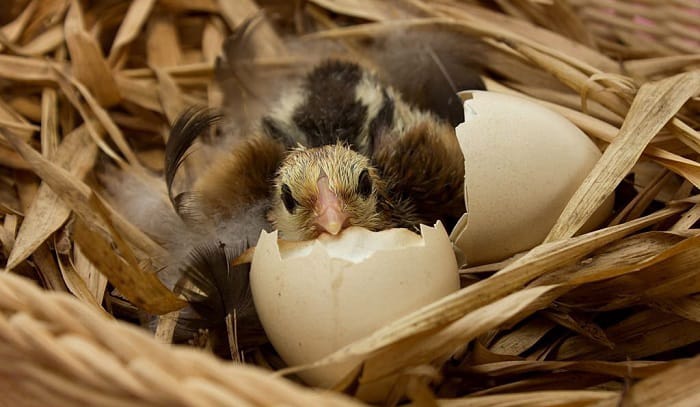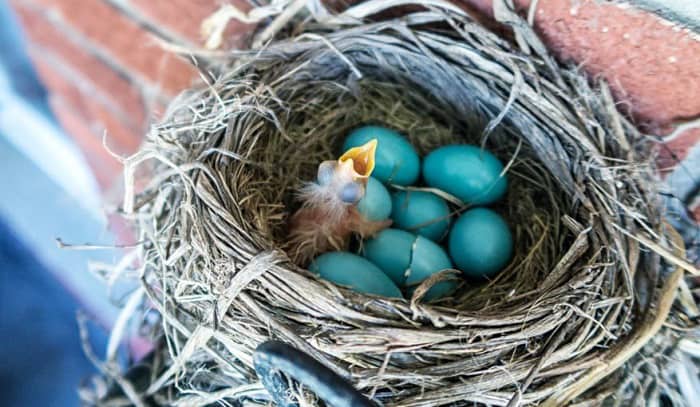The answer to how many times a year do birds lay eggs is several times. The number of times birds lay eggs in a year could vary depending on the bird species and several factors. Some birds lay only one egg per year, while others can lay up to ten eggs or even more.
Knowing this is vital in understanding birds’ breeding habits and environmental adaptation. Whether you are a birder looking for this important piece of information to improve your experience or just a curious reader, learn about how often do birds lay eggs and more here.
Table of Contents
How Many Times a Year Do Birds Lay Eggs?
The number of eggs laid during a nesting attempt or the clutch size varies widely among and between avian species. The clutch size refers to the total number of eggs a female lays in a nesting effort before she incubates them to hatch. Some birds lay one egg per day; others lay less than 50 eggs in a lifetime.
Birds like penguins, doves, and hummingbirds have one to two eggs per clutch, while geese and ducks have as many as 20. Wrens, with a clutch size of four to seven, have two broods or hatches per year, and if the first one doesn’t survive, a second one is laid.
Albatrosses sexually mature when they are five years old, laying only a single egg a year. However, they produce an optimal clutch throughout their lifetime, which is the net number of younglings to replace the parents. Several factors influence this variation between the species. The frequency will depend on the following determinants.
1. Fitness
In evolutionary biology, this term explains the reproductive success of avians in producing healthy offspring. The reproductive potential of a bird is the most important factor in deciding it will lay eggs, while the food source affects the laying intervals.
Females often choose to breed earlier to mate with stronger sexual signals and rely on enough territory food. This setup increases the reproductive success and survival advantage of birds and younglings compared to those who reproduce later. Late fledging is at greater risk of environmental pressures, like competition for decreasing food sources and higher predation.
2. Day Length
The length of daylight, also called day length or photoperiod, is a significant cue for birds to lay their eggs. It involves the secretion of specific hormones that affect the size of sexual organs. This hormonal change prepares their bodies for mating and breeding.
The growth of birds’ sexual organs is found to be directly proportional to day length. That is why many birds make and lay eggs when the day lengthens, specifically after winter, in the late spring, and summer. It also influences the prevailing food sources in their surroundings.
3. Latitude Location
The location of the bird in latitude controls when they will lay their eggs. Wild birds living in higher latitudes have a briefer duration for mating and laying eggs compared to their peers living at lower latitudes in the south. This is because the shorter days limit their time to find a mate, build a nest, and lay their eggs. The brief season also results in the faster development of young birds.
When do birds lay eggs? Birds lay their eggs in spring. Again, depending on the species, birds can begin laying eggs at an earlier date than others, but most of these fall in April, May, and June. The above-mentioned factors are also the ones responsible for when birds lay their eggs.
The Nesting Cycle
Species of nesting birds behave differently during their nesting cycle. However, the general pattern is finding a mate, building a nest, laying eggs, and raising their young.
1. Choosing a Mate
Females choose their mates based on their vigor and overall quality. Males attract females with their courtship displays, which involves showing their nest-building skills, bringing food, singing, and calling.
2. Building a Nest
Before nesting season arrives, finding a place to breed is crucial. Non-migratory birds either maintain their territory or settle on a new one during spring. Migratory birds will find and defend their territories after arriving. The best breeding places offer potential nesting sites, abundant food sources, and protection from predators.
When building a nest, the process differs for each species, as each one has its own distinct style. Some are made of fur, grass, mud, leaves, plastic, yarn, or paper. Other birds don’t make nests and just lay their eggs on the ground.
3. Egg Laying
A bird pregnant before laying eggs is not possible since they are not mammals. Instead, the female lays eggs after mating and sits on them to incubate the eggs. They do this to keep the eggs at the right temperature for normal development. It usually lasts 21 days.
4. Raising the Young
The newly hatched birds stay in the nest where they are fed and protected by their parents. The hatchlings cannot control their body temperature and should be brooded by their parents to stay warm. After the first week, remarkable growth will happen.
Feeding the young is a dangerous time for both the young and the adults. To keep up with the nestling’s food demands, parents must continuously forage. This will leave the young birds alone in the nest with their begging cries that can attract predators. There are species that stay for weeks with their newly hatched eggs, while others rarely stay in the nest as they search for food hours after emerging from the egg.
Young birds stay with their parents for a short time to learn survival skills despite being defenseless against predators and prone to starvation. Surviving the first year is the toughest, but the odds improve after that.
Conclusion
There are a lot of things to learn about the factors that affect birds laying eggs and their nesting cycles. We hope this article presented you with the answer to, “How many times a year do birds lay eggs?”
If you know someone interested in knowing how many eggs do birds lay in a year, share this article with them. It will surely satisfy their curiosity and teach them new things. Have you witnessed a bird laying eggs once a year? Share your experience with us in the comment section!

George and I became friends after a birdwatching trip with our new group. And we have been enjoying every adventure together. When he told me the idea of establishing a site that shares our experiences and fun, I immediately agreed. After trials and errors, here we have Thayerbirding.
















